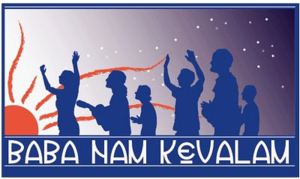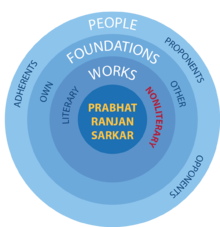User:Abhidevananda/Sandbox8
 | This is Abhidevananda's sandbox for new articles. It serves as a testing spot and page development space. This is not an encyclopedia article. |
| Kiirtan | |
|---|---|
 | |
| Founder(s) | Shrii Shrii Anandamurti |
| Type | Spiritual practice |
| Region served | Worldwide |
| Location in Sarkarverse | |
Kiirtan (or kiirtana} is the chanting out loud of a specially empowered mantra, an 8-syllabled siddha mantra (perfect incantation). In Ananda Marga, the mantra used is Bábá nám kevalam.
History
Amjhariya 1970 October 8
Tradition
Classical kiirtan Several examples in Prabhat Samgiita.
Practice
- General kiirtan (with or without dance)
- Akhańd́a kiirtan
- Kathá kiirtan
- Nagar kiirtan
- Ávarta kiirtan
Benefits
Both individual and collective. Even to those who just happen to hear, but still more to those who participate.
Perfect kiirtan
In 1982 (exact date unknown), Shrii Shrii Anandamurti gave a discourse in which were set out the requirements for a perfect kiirtan. Many other topics were also addressed, for example the appropriate ideation to be taken while practicing kiirtan and why a siddha mantra[nb 1] must have eight syllables. This discourse was distributed in the form of cyclostyled sheets under the title of "Bio-psycho-spiritual System of Kiirtan". Ac. Abhidevananda Avadhuta kept secure his copy of that discourse. In the mid-1990s he submitted his copy to the Central Publications Department of Ananda Marga Pracaraka Samgha, which had put out a request for any lost discourses. However, this discourse was only published subsequent to a reminder and after more than six years (in 2002).[1]|group="nb"}} When the discourse was published, it went out in a mangled form (minus the explanatory Saḿskrta and with misleading rather than constructive footnotes). Below is the complete discourse in its original form and with useful footnotes.
Bio-psycho-spiritual System of Kiirtan
- An action may be treated as 'finality' if it satisfies the following conditions: 1. it has been fully complied with 2. the result of the compliance is in hand. This type of completion is known as upavasya.[nb 2] We repeat siddha mantra (Iśt́a) in different tunes. What is the upavasya of it? Let us take an example. I cross the threshold and as a result of it I enter the room. The utterance (internal or external) of the first syllable of a mantra is like crossing the threshold and entering a new world. The proper accomplishment of work after entering the new world culminates into a result which gives a feeling of bliss and perfection. This feeling is an embodiment of pleasure.
- In day-to-day life, we first inhale and then exhale. The mantra is repeated according to the syllabic rhythm of inhalation and exhalation. This act of breathing in the mundane sphere has no end in individual life. Breathing is an action and so a living being is always engaged in some sort of action. This constant effort is known as Yatamána. This is the first stage of progress. In the second stage, he wants to rise high with the firm determination to achieve his goal. And while doing so he is in a position to have control over some or other of his mental propensities for some time, but has no control on the other propensities at all. This stage is known as Vyatireka. In this stage he achieves concentration for some time and then again loses it. Then comes Ekendriya, which is the third stage of progress in sádhaná. This is the stage when he has control over a particular mental propensity, and that control is more lasting. Due to constant repetition the mantra is sounding at his ear. While sitting in meditation a sadhaka can see Iśt́a[nb 3] moving around him and the fragrance of sandalwood or rose coming from the body of Iśt́a. Sometimes he is getting it and sometimes he is not getting it. The fourth stage is known as Vashiikára. There he is established in ideation of Parama Puruśa[nb 4] to satisfy Whom he is doing kiirtan. Here he completely surrenders himself before Parama Puruśa, and he is under the complete control of Parama Puruśa. So there are four stages – once at the time of inhalation and again at the time of exhalation. So in all there are eight facets, and a siddha mantra is necessarily to have eight syllables – it must be aśt́ákśarii.[nb 5] That is why each and every syllable of [a siddha mantra]{{#tag:ref|On the cyclostyled sheet, it read "Iśt́a Mantra". Presumably, that was a typo.|group="nb"} has got its own importance. Bábá Náma Kevalama is a siddha mantra. Where the first syllable "Bá" is uttered, the feeling should be that I am crossing the threshold and entering the new world; and when the last syllable "ma" is uttered, the feeling should be that I have accomplished my duty. If kiirtan is done with these feelings, within 2-3 minutes the effect of kiirtan will have its play.
- The whole siddha mantra should be uttered fully in each phrase of the tune – Bábá Nám Kevalam, and not a part of it – while doing kiirtan.[nb 6] If it is not done, the kiirtan cannot be said to be a perfect kiirtan. Everything must be done in a methodical way. Then you will enjoy and get the upavasya of kiirtan properly.
Accounting for the dogma of serial kiirtan
The "Bio-psycho-spiritual System of Kiirtan" discourse was first published only in 2002, 20 years after the instructions were given and even 12 years after Shrii Shrii Anandamurti had physically departed. In 2002, some persons who saw the instructions in the final paragraph for the first time, misinterpreted their meaning and even failed to consider the way in which kiirtan was practiced in the 1980s and 1990s (and did not even examine videos of kiirtan taken in the 1980s with Shrii Shrii Anandamurti present and appreciative). Without thinking carefully, they imagined that they had discovered some previously unknown instruction. And ignoring the fact that the instruction pertains to musical phrases, they propagated the dogma that kiirtan must be done by repeating only "Bábá Nám Kevalam, Bábá Nám Kevalam, Bábá Nám Kevalam".
Notes
- ^ A special type of mantra suitable for general use.
- ^ In Saḿskrta, upavas means "to dwell at or in". With the suffix ya, the meaning is "the result of dwelling at or in".
- ^ The Ideal in form of one's spiritual master.
- ^ The Supreme Consciousness.
- ^ The calculation of what constitutes aśt́ákśarii (having eight syllables) is based on the root sounds (mostly vowels) located at the Vishuddha Cakra.
- ^ Here it must be noted that in 1982, some kiirtans that were practiced did not include the full siddha mantra in every musical phrase. For example, at times there were musical phrases with only Bábá Nám and no Kevalam. Due to the somewhat confusing way in which this instruction came out in writing, at the class which accompanied the distribution of this discourse, it was asked whether this meant that we should only sing "Bábá Nám Kevalam, Bábá Nám Kevalam" in a serial fashion. The response was an emphatic No. It only meant that every musical phrase should contain at least one complete Bábá Nám Kevalam and not just a fragment or fragments of the siddha mantra. In other words, a musical phrase that goes "Bábá Nám Bábá Nám Kevalam" is perfectly acceptable, but a musical phrase that goes "Bábá Nám Bábá Nám Bábá Nám" is not.
References
- ^ Shrii Shrii Anandamurti (1996) "Appendix: From the Notebooks of Devotees" in Acarya Vijayananda Avadhuta Ananda Vacanamrtam Part 30 (in English) Kolkata: Ananda Marga Publications ISBN 81-7252-101-4}}
